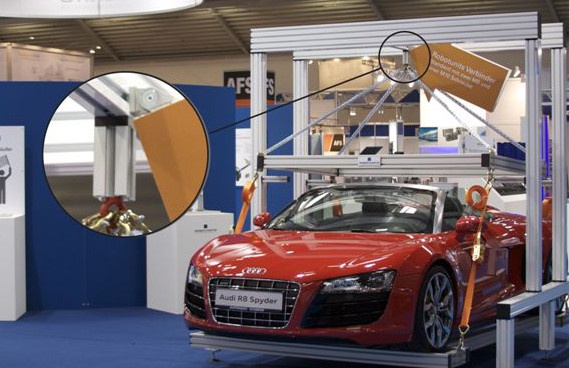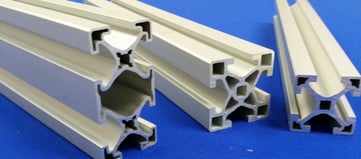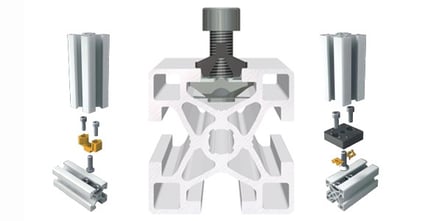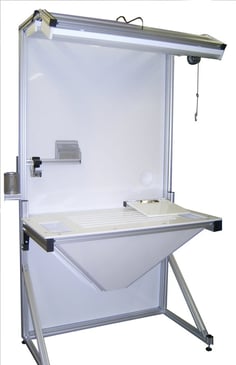,
Whether you’re setting up automation equipment for a large assembly line or a workstation for a single employee, chances are you’ll need a metal framework to mount robotic parts, dispensers, or other automated assembly equipment. Many plant owners choose traditional welded steel structures for their strength and permanence. However, aluminum extrusion frames are also gaining in popularity, and for several good reasons.
Aluminum extrusion frames are a modular solution, consisting of bars of extruded aluminum with a unique T-slot design. A set of specialized connectors allow the purchaser to construct whatever structure he or she needs.

Because the framework is aluminum, it often has a higher price tag than steel (though less than stainless steel). But we’ve found that aluminum extrusion frames offer distinct advantages over welded steel systems:
1. Ease of Assembly
 Steel may be less expensive than aluminum, but it also requires a labor-intensive setup. You’ll need to hire an assembly crew to put the heavy pieces into place and employ a professional welder (or find someone on your team with welding experience and the specialized equipment). This requires a period of downtime—you can’t have employees nearby while welding is underway—plus cleanup afterward.
Steel may be less expensive than aluminum, but it also requires a labor-intensive setup. You’ll need to hire an assembly crew to put the heavy pieces into place and employ a professional welder (or find someone on your team with welding experience and the specialized equipment). This requires a period of downtime—you can’t have employees nearby while welding is underway—plus cleanup afterward.
With T-slot aluminum extrusion systems, however, a single employee can assemble a station using just hand tools. The connectors lock tightly into the slots and little, if any, cleanup is required.
In addition, steel surfaces need to be cleaned and painted before use, which adds an additional step. Aluminum extrusion pieces, however, are anodized and don't require any painting or coating.
2. Adaptability to Changes
When planning a welded structure, every measurement and mounting bolt must be precisely determined ahead of time. Once the structures are permanently welded together and holes are drilled into exact spots, it’s difficult to correct mistakes. And if equipment or processes change down the road, the welded structure may not be able to adapt.
Aluminum extrusion frame systems, on the other hand, are far more flexible. Pieces can be disconnected and then re-assembled as needed, and it’s simple to move connectors a few inches here or there to allow for changes in mounting.
3. Damage Management
 If part of a steel structure becomes damaged during production, repairing it will probably require the damaged piece to be cut out and a new piece to be welded back in—a complicated and time-intensive process. But because of the modular nature of aluminum structural framing, swapping out a damaged bar is simple and doesn’t require much production downtime.
If part of a steel structure becomes damaged during production, repairing it will probably require the damaged piece to be cut out and a new piece to be welded back in—a complicated and time-intensive process. But because of the modular nature of aluminum structural framing, swapping out a damaged bar is simple and doesn’t require much production downtime.
Also, because steel is vulnerable to rust, it often requires a protective coating to help slow the inevitable process. Aluminum, on the other hand, by nature does not rust, meaning it can last longer even in humid environments.
Final Thoughts
Be sure to note that while one of aluminum’s great benefits is its lightness, it’s not quite as strong as steel. Historically it has only been used for lightweight applications such as machine guarding. However, the Robotunits aluminum extrusion system offered by Izumi International features a patented connection system which can withstand more vibration and heavier loads. (It's a Robotunits system in the first photo that is holding up the weight of a car with just one joint!)
Each application should be evaluated for its loads and forces, but the Robotunits extrusion frame system has been used successfully for robot bases and for frames for high-speed automated equipment.
Not sure which framing system is right for you? The experts at Izumi International will be happy to help you develop a custom solution for your needs. Call us at 864.288.8001, or request an estimate below.


